HiPACC Computational Astronomy Press Room. From: SDSC
The Press Room highlights computational astronomy work around the UC-HiPACC consortium; the wording of the short summaries on this page is based on wording in the individual releases or on the summaries on the press release page of the original source. Press releases below appear in reverse chronological order (most recent first); they can also be displayed by UC campus or DOE lab by clicking on the desired venue at the bottom of the left-hand column.
July 8, 2014 — Small but plentiful: How the faintest galaxies illuminated the early universe
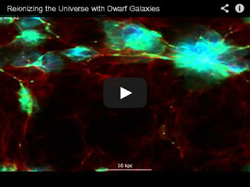
Video from the simulations, done using SDSC’s Trestles supercomputer and additional systems at NASA: Reionizing the Universe with Dwarf Galaxies.
SDSC 7/8/2014—Light from tiny galaxies more than 13 billion years ago played a larger role than bigger galaxies in creating the conditions in the universe as we know it today, according to a new study by researchers at the San Diego Supercomputer Center (SDSC) at UC San Diego and at the Georgia Institute of Technology. Ultraviolet (UV) light from stars in these faint dwarf galaxies helped strip interstellar hydrogen of electrons in a process called reionization, the researchers said in a paper published in the journal
Monthly Notices of the Royal Astronomical Society. The epoch of reionization began about 200 million years after the Big Bang and astrophysicists agree that it took about 800 million more years for the entire universe to become reionized—the last major phase transition of gas in the universe (it remains ionized today). The team’s simulations modeled the flow of UV stellar light through the gas within galaxies as they formed. “That such small galaxies could contribute so much to reionization is a real surprise,” said Michael Norman, SDSC director and one of the co-authors.
View SDSC Press Release
October 24, 2013 — Scientists Solve Mystery of Odd Patterns of Oxygen in Solar System’s Earliest Rocks
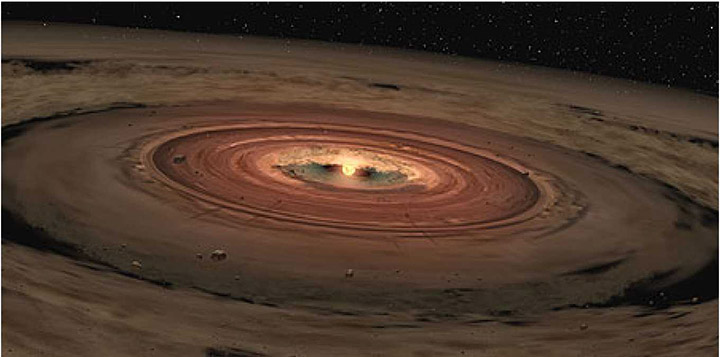
The earliest dust and rocks forming in the solar nebula. Credit: NASA.
Cosmochemists at the University of California, San Diego, have solved a long standing mystery in the formation of the solar system: Oxygen, the most abundant element in Earth’s crust, follows a strange, anomalous pattern in the oldest, most pristine rocks, one that must result from a different chemical process than the well-understood reactions that form minerals containing oxygen on Earth.
view full SDSC Press Release
May 3, 2013 — Extreme Star Formation Reveals a Fleeting Phase of Galactic Evolution

Infrared light pours from the galaxy, just a tiny red dot in this wide-angle view of the sky captured by WISE. Image credit: NASA
A team of nine astronomers, including two from UC campuses, have spotted a galaxy that is igniting new stars faster than ever seen before. Measurements from several space-based and ground-based instruments (including from the W. M. Keck Observatory on Mauna Kea) show that gas in this galaxy is condensing to form stars close to the maximum rate thought possible.
view full UCSD Press Release
February 28, 2013 — SDSC helps craft Big Data top 100 list
The San Diego Supercomputer Center at UC San Diego, today announced plans for a community-based effort to create the BigData Top100 List, the first global ranking of its kind for systems designed for big data applications. Although this release does not specifically mention computational astronomy, there is a huge amount of astronomical big data. Also mentions a new journal Big Data started in March, whose editorial board includes Michael Franklin from UC Berkeley and other researchers from elsewhere in California.
view full UCSD Press Release
February 20, 2013 — Searching for the Solar System’s Chemical Recipe
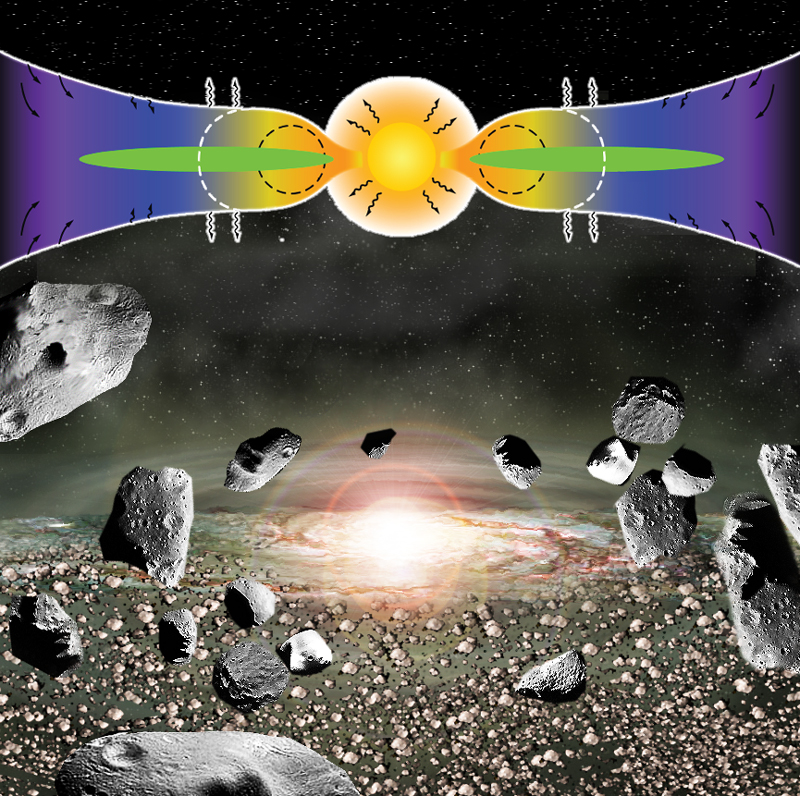
The protosun evolved in a hot nebula of infalling gas and dust that formed an accretion disk (green) of surrounding matter. Visible and ultraviolet light poured from the sun, irradiating abundant clouds of carbon monoxide, hydrogen sulfide, and other chemicals. Temperatures near the sun were hot enough to melt silicates and other minerals, forming the chondrules found in early meteoroids (dashed black circles). Beyond the “snowline” (dashed white curves), water, methane, and other compounds condensed to ice. Numerous chemical reactions contributed to the isotopic ratios seen in relics of the early solar system today.
The ratio of isotopes in elements like oxygen, sulfur, and nitrogen in meteorites, interplanetary dust and gas, and the sun itself differ from isotope ratios on Earth. In a paper published by the Proceedings of the National Academy of Sciences, planetary researchers at UC San Dieto and Lawrence Berkeley National Laboratory describe how they used LBNL’s Advanced Light Source to study these “mass-independent” effects to explore their origins in the chemical processes of the early solar system.
view full LBNL Press Release
February 1, 2013 — SDSC Mourns the Loss of Dr. Robert P. Harkness
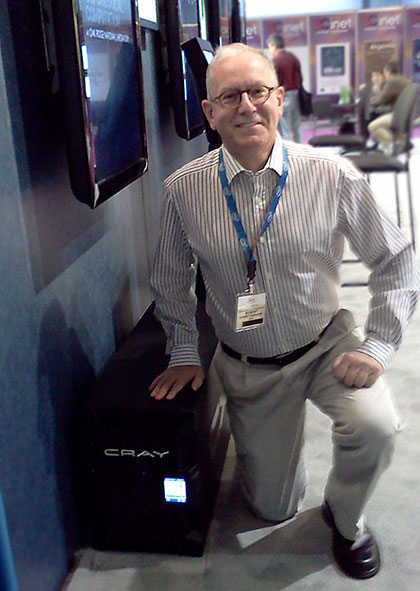
Dr. Robert P. Harkness
Robert P. Harkness, a computational astrophysicist with the San Diego Supercomputer Center (SDSC) at the University of California, San Diego, died on Sunday, January 27, after a brief bout with cancer. He was 56. With a total of more than 30 years’ experience in computational science and high-performance computing, he focused much of his research on the dynamics of exploding stars (novae and supernovae), but also specialized in writing new applications that allowed researchers worldwide to perform ever-larger computer simulations.
view full SDSC Press Release
March 5, 2012 — SDSC’s ‘Gordon’ Supercomputer: Ready for Researchers
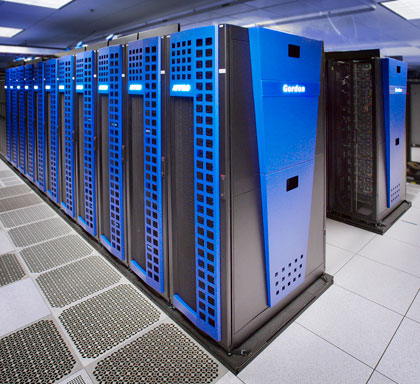
SDSC's Gordon Supercomputer. Photo: Alan Decker.
Accurately predicting severe storms, or what Wall Street’s markets will do next, may become just a bit easier in coming months as Gordon, a unique supercomputer at the San Diego Supercomputer Center (SDSC) at the University of California, San Diego, begins helping researchers delve into these and other data-intensive projects.
Following acceptance testing in January, Gordon has now begun serving University of California and national academic researchers as well as industry and government agencies. Named for its massive amounts of flash-based memory, Gordon is part of the National Science Foundation’s (NSF) Extreme Science and Engineering Discovery Environment, or XSEDE program, a nationwide partnership comprising 16 supercomputers and high-end visualization and data analysis resources...
view SDSC Press Release





